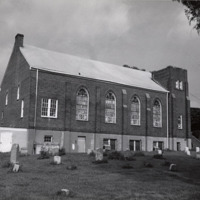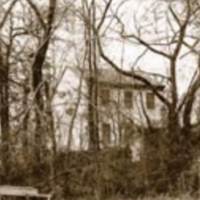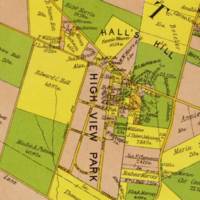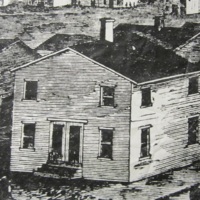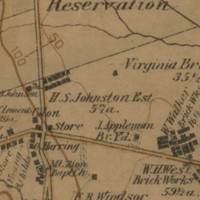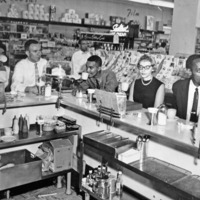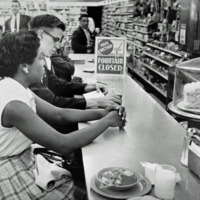Browse Items (28 items total)
The Lomax Afro Methodist Episcopal (AME) Zion Church is a 45' x 72' two-story, gabled roof, brick structure. The church features a small cemetery to the right side where approximately 50 church members and community leaders were interred from the 1880s to 1965.
The church first began as Little Zion Methodist Church in Freedman's Village in 1866. In the 1880s the congregation moved to Green Valley. Before a new church building could be created services were held in the home of community leaders Levi and Sarah Ann Jones. In 1876 a one acre plot was purchased for $75 and a new church, now called Lomax AME Zion, was constructed, using wood preserved from the original Freedman's Village structure. The church was expanded in 1889 and in 1922 the present building was completed.
The church first began as Little Zion Methodist Church in Freedman's Village in 1866. In the 1880s the congregation moved to Green Valley. Before a new church building could be created services were held in the home of community leaders Levi and Sarah Ann Jones. In 1876 a one acre plot was purchased for $75 and a new church, now called Lomax AME Zion, was constructed, using wood preserved from the original Freedman's Village structure. The church was expanded in 1889 and in 1922 the present building was completed.
Collection: Community Institutions
Levi Jones and his wife Sarah were two of the earliest settlers of Green Valley, today known as Nauck.
In 1844 the couple built a 14' x 16', two story log cabin. During the Civil War, federal troops destroyed their original home. But following the war they were able to rebuild, creating the home pictured here.
The Jones were influential community leaders. Before other accommodations could be made, they hosted church services in their home. They sold land to freed slaves following the Civil War. These sales, along with interest from Washington, D.C. land speculator John Nauck, a white businessman who sold land to African Americans in the Green Valley area, strengthened and expanded the black community there. Their impact on Nauck's black community continued into the twentieth century, when the federal government built the Paul Dunbar Homes on 11 of their original homestead in 1942.
Levi and Sarah had two sons, Levi and Isaac, and three daughters, Mary, Martha, and Louise. Levi died in 1886 and Sarah followed in 1913 at the age of 95. They are buried at the Lomax AME Cemetery.
In 1844 the couple built a 14' x 16', two story log cabin. During the Civil War, federal troops destroyed their original home. But following the war they were able to rebuild, creating the home pictured here.
The Jones were influential community leaders. Before other accommodations could be made, they hosted church services in their home. They sold land to freed slaves following the Civil War. These sales, along with interest from Washington, D.C. land speculator John Nauck, a white businessman who sold land to African Americans in the Green Valley area, strengthened and expanded the black community there. Their impact on Nauck's black community continued into the twentieth century, when the federal government built the Paul Dunbar Homes on 11 of their original homestead in 1942.
Levi and Sarah had two sons, Levi and Isaac, and three daughters, Mary, Martha, and Louise. Levi died in 1886 and Sarah followed in 1913 at the age of 95. They are buried at the Lomax AME Cemetery.
Collection: Neighborhoods
The community of Hall's Hill, today called High View Park, was established in 1865 when white land-owner Bazil Hall, hit with hard-times following the Civil War, sold lots of his land to formerly enslaved African Americans. From these beginnings Hall's Hill became a thriving black community.
Local community institutions of note include Glebe Elementary School, Langston Brown Community Center, Calloway United Methodist Church, and Fire Station #8, Arlington's first African American fire company. Hall's Hill is one of the few remaining African American neighborhoods in Arlington. During the mid-twentieth century, the bordering white community built a cinder-block wall around Hall's Hill to physical separate themselves from their black neighbors during formal, legalized residential segregation. Pieces of that wall remain.
The community is bounded North by Lee Highway, East by Glebe Road, South by 17th Street North, and West by George Mason Drive. This map shows the growing community in 1900.
Local community institutions of note include Glebe Elementary School, Langston Brown Community Center, Calloway United Methodist Church, and Fire Station #8, Arlington's first African American fire company. Hall's Hill is one of the few remaining African American neighborhoods in Arlington. During the mid-twentieth century, the bordering white community built a cinder-block wall around Hall's Hill to physical separate themselves from their black neighbors during formal, legalized residential segregation. Pieces of that wall remain.
The community is bounded North by Lee Highway, East by Glebe Road, South by 17th Street North, and West by George Mason Drive. This map shows the growing community in 1900.
Collection: Neighborhoods
Freedman's Village was a contraband camp created by the War Department and strengthened by Arlington's African American community. The Village, located on the lands of Robert E. Lee's Arlington plantation, was a black neighborhood in Arlington from 1863 until 1900.
Here 100 white-washed, one-and-a-half story duplexes, like the one pictured, were constructed along a quarter-mile long thoroughfare through the Village. The clapboard houses used a paired-down version of the Classical Revival style. This housing type remained a popular choice for African American communities in Arlington throughout the early twentieth century.
Here 100 white-washed, one-and-a-half story duplexes, like the one pictured, were constructed along a quarter-mile long thoroughfare through the Village. The clapboard houses used a paired-down version of the Classical Revival style. This housing type remained a popular choice for African American communities in Arlington throughout the early twentieth century.
Collection: Neighborhoods
Johnson's Hill, today known as Arlington View, is an African American community located along Columbia Pike which first began ca. 1880. Here a tollgate was created at the intersection of Columbia Pike and the Georgetown-Alexandria Pike (today South Arlington Ridge Road). A small village center with houses, two stores, a post office, and a blacksmith shop formed around this tollgate, helping to expand and strengthen this African American community.
Collection: Neighborhoods
On June 23, 1960, after two weeks of coordinated sit-in efforts across the county, leaders from the Non-Violent Action Group (NAG) enjoy cups of coffee at the Drug Fair. The company announced the day before that it would integrate its lunch counters in the Washington area. Within weeks more restaurants and lunch counters in Arlington desegregated their services as a result of the sit-ins.
Those pictured include Dion Diamond (corner seat),Laurence Henry (far right), and Paul Dietrich (second from left).
Those pictured include Dion Diamond (corner seat),Laurence Henry (far right), and Paul Dietrich (second from left).
Collection: Civil Rights
Non-Violent Action Group (NAG) activists Dion T. Diamond (left) and Laurence Henry are arrested by Arlington Police Sergeant Roy G. Lockey (left) and Lt. Ernest A. Summers. The two were arrested while demonstrating at the Howard Johnson's restaurant in Arlington.
This scene was a part of a coordinated sit-in movement which occurred across several Arlington lunch counters in June of 1960 to protest segregated accommodations. These demonstrations ultimately led to the integration of restaurants in Arlington. But unfortunately this did not end racism. African American resident Princeton Simms recalled that despite integration proprietors would “pick up the plate and throw it in the trash” after they were used by black patrons. This kind of outward hostility meant many black customers continued to prefer to patronize black owned restaurants despite integration.
This scene was a part of a coordinated sit-in movement which occurred across several Arlington lunch counters in June of 1960 to protest segregated accommodations. These demonstrations ultimately led to the integration of restaurants in Arlington. But unfortunately this did not end racism. African American resident Princeton Simms recalled that despite integration proprietors would “pick up the plate and throw it in the trash” after they were used by black patrons. This kind of outward hostility meant many black customers continued to prefer to patronize black owned restaurants despite integration.
Collection: Civil Rights
Gwendolyn Greene (later Britt) sits at the People's Drug Store Counter in Arlington Virginia. When she sat down to request service the workers left the store, only returning once management closed the counter.
This scene was a part of a coordinated sit-in movement which occurred across several Arlington lunch counters in June of 1960 to protest Arlington's segregated accommodations.
This scene was a part of a coordinated sit-in movement which occurred across several Arlington lunch counters in June of 1960 to protest Arlington's segregated accommodations.
Collection: Civil Rights
